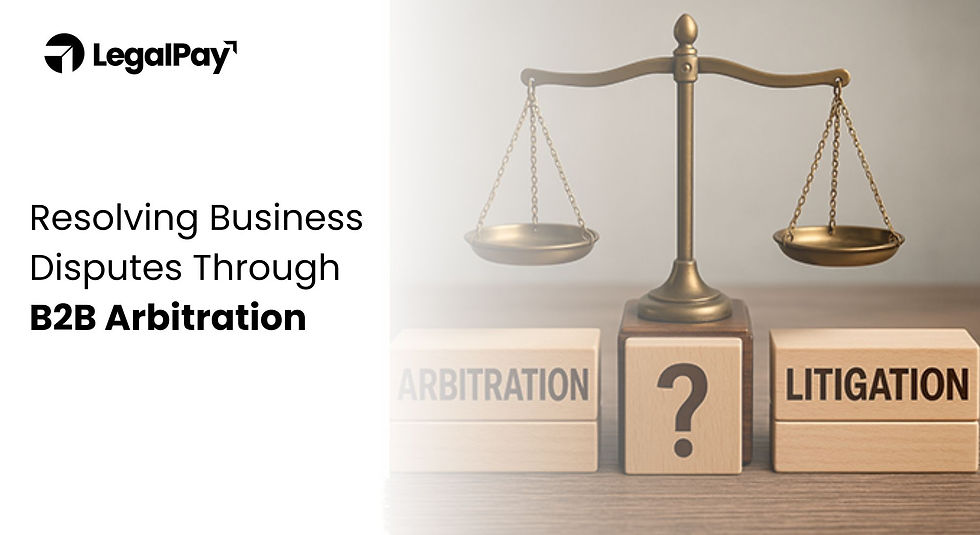Structures of Litigation Funding: Unlocking Financial Power for Legal Battles
- Simoni Pant
- Jun 7
- 8 min read
Updated: Jul 27

“How can businesses and individuals manage the soaring costs of legal disputes without sacrificing their chances of justice?”
This question lies at the heart of the modern legal world, where LF has emerged as a transformative solution.
LF: the financial support given to litigants or law firms to cover legal expenses in exchange for a portion of the eventual recovery, is reshaping how legal battles are fought globally, and India is no exception.
This blog dives deep into the various structures of LF, their applications, emerging trends, challenges, and how strategic use of these structures can empower you in commercial litigation, arbitration, or dispute resolution processes.
Understanding Litigation Funding Structures

LF is not a one-size-fits-all solution. Different structures have evolved to meet the varying needs of claimants, law firms, and funders. Let’s explore the most common forms:
Single-Case Funding
This is the most straightforward model, where funding is provided for one particular case. It suits claimants with a strong, high-value claim and a clear timeline for resolution. The funder conducts due diligence and, if satisfied, agrees to cover legal costs in exchange for a pre-agreed share of the recovery.
Portfolio Funding
Portfolio funding supports a group or bundle of cases, often managed by a law firm or corporate entity. By financing multiple claims simultaneously, funders diversify risk and allow firms to manage cash flows better. This is especially useful for firms dealing with numerous commercial litigation or corporate litigation matters.
Law Firm Financing
In this structure, LF is provided directly to law firms rather than individual clients. It enables firms to finance multiple cases or invest in legal resources, technology, and expertise without immediate reliance on client payments. This fosters growth and operational flexibility.
Arbitration Funding
With arbitration becoming a preferred form of dispute resolution, specialized funding for arbitration proceedings has emerged. Funders back claimants or respondents in arbitration tribunals, particularly in complex contract disputes or B2B legal disputes, where costs can be substantial.
Emerging Trends in Litigation Funding: What’s Shaping the Future?
LF is evolving rapidly with several emerging trends transforming its landscape. Understanding these trends is crucial for businesses and legal teams looking to harness funding effectively.
Rise of Litigation Finance Funds and Specialized Funds
Specialized litigation finance funds are gaining prominence, raising large pools of capital dedicated solely to funding disputes. These funds operate similarly to venture capital or private equity but focus exclusively on legal claims.
Such funds bring:
Greater financial muscle for large-scale cases.
Professionalized portfolio management applying rigorous financial metrics.
Attractive exit options through settlements or judgments.
The presence of these funds attracts more claimants and law firms to consider LF as a mainstream financial solution.
Increased Use of Portfolio Funding by Law Firms
Law firms, especially those handling complex commercial and corporate litigation, increasingly leverage portfolio funding to manage cash flow and risk.
Instead of financing each case separately, firms secure capital against a bundle of cases. This allows firms to:
Balance risk across multiple clients.
Offer clients deferred payment options.
Invest in technology and expert resources.
Portfolio funding can help law firms grow sustainably and take on higher-value disputes without worrying about immediate payment.
Expansion into Non-Traditional Legal Claims
Originally focused on commercial disputes and corporate litigation, LF is expanding into areas like:
Intellectual property enforcement.
Class actions and mass torts.
Insolvency and bankruptcy-related litigation.
Employment law disputes.
This expansion shows how adaptable LF is, offering financial support across diverse legal challenges.
Challenges and Limitations of Litigation Funding
Despite its benefits, LF is not without hurdles. Claimants, funders, and lawyers must navigate certain challenges to maximize outcomes.
Regulatory and Legal Ambiguity
In many jurisdictions, including India, the lack of a comprehensive legal framework governing third-party LF creates uncertainty.
Questions around:
Disclosure requirements in court.
Conflicts of interest.
Funder control over legal strategy.
Ethical boundaries for lawyers.
pose ongoing concerns. Clear regulations are essential to build confidence and avoid misuse.
Due Diligence Complexity and Cost
Performing thorough case evaluation requires significant expertise, time, and resources. Funders must assess legal merits, financial viability, and enforceability risks accurately to avoid losses.
This process can delay funding availability and increase transaction costs, especially for smaller claims.
Risk of Over-Litigation and Moral Hazard
There is a potential for funders to encourage overly aggressive litigation to maximize returns, possibly prolonging disputes unnecessarily.
Balancing commercial interests with ethical dispute resolution requires careful governance.
Confidentiality and Privacy Concerns
Funding agreements often contain sensitive financial and legal information. Ensuring confidentiality while complying with disclosure obligations can be challenging.
How Litigation Funding Interacts with Alternative Dispute Resolution (ADR) Mechanisms
LF is increasingly being used to support disputes resolved through ADR processes such as arbitration tribunals and mediation.
Funding Arbitration Proceedings
Arbitration is a preferred method for commercial disputes due to its confidentiality and speed compared to court litigation. However, arbitration can still be expensive.
Funding arbitration allows claimants to pursue complex cases involving contract disputes or B2B legal disputes without upfront financial stress.
Since arbitration awards are binding and enforceable globally, funders often view arbitration cases as attractive investments.
Supporting Mediation and Settlement Efforts
While funding is usually associated with adversarial proceedings, funders recognize the value of mediation and negotiated settlements.
By financing the upfront legal work and preparation, funders enable parties to engage in mediation from a position of strength, increasing the likelihood of successful outcomes.
Practical Considerations When Choosing a Litigation Funding Structure
For businesses and law firms considering LF, several factors influence the choice of funding structure.
Case Complexity and Duration
Single-case funding is suitable for straightforward, high-value disputes with clear timelines.
Portfolio funding suits firms managing multiple cases with varying durations.
Risk Appetite and Financial Stability
Companies with lower risk tolerance may prefer diversified portfolio funding to mitigate losses.
Relationship with Law Firms
Firms seeking working capital may opt for law firm financing, supporting their operations and client services.
Jurisdictional Factors
Cross-border disputes require funders experienced with international arbitration and local enforcement.
Cost and Return Expectations
Understanding the funding fees, share of recovery, and exit terms is vital to ensure economic viability.
The Role of Legal Litigation Firms in Litigation Funding Ecosystems
LF often involves close collaboration with litigation law firms who:
Provide expert case assessments.
Advise on funding strategies.
Manage the litigation process and interact with funders.
Firms with experience in commercial litigation finance become key partners, ensuring alignment of legal and financial goals.
How Litigation Funding Supports Legal Recovery Solutions Beyond Litigation
LF is increasingly integrated with broader legal recovery solutions including:
Debt recovery.
Bad debt recovery.
Corporate debt collection.
By bridging finance and legal expertise, funding solutions enable clients to recover owed amounts efficiently, especially in sectors facing chronic payment delays.
Measuring Success in LF: Beyond Winning the Case
Success in LF is multifaceted. It includes:
Achieving favorable legal outcomes.
Recovering maximum damages or settlements.
Maintaining client financial health throughout disputes.
Minimizing time to resolution.
Building long-term funder-client relationships for future cases.
Funders and claimants must set clear metrics to evaluate impact.
LF in the Context of Lawsuit Financing and Case Funding Ecosystem

LF is a part of the broader lawsuit financing landscape, which includes:
Legal cost assistance products helping pay for expert fees or court expenses.
Pre-settlement funding providing advances on anticipated awards.
Third-party litigation finance enabling non-recourse investments.
Understanding these options helps clients select the best funding mix.
Why LegalPay Stands Out as a LF Partner
At LegalPay, we integrate innovative technology, legal expertise, and client-centric approaches to deliver comprehensive case funding solutions.
Our platform offers:
Transparent terms.
Rigorous case evaluation.
Flexible funding structures tailored to client needs.
Dedicated support throughout the legal journey.
We empower clients to fight their legal battles without financial anxiety, improving access to justice and business resilience.
The Impact of LF on Access to Justice and Legal Strategy
One of the most significant, yet often underappreciated, effects of LF is its role in democratizing access to justice. For many businesses and individuals, the prohibitive costs of commercial litigation, arbitration, or lengthy corporate litigation processes can be an insurmountable barrier.
LF removes this financial hurdle by providing the necessary capital to pursue legitimate claims or defenses. This is particularly critical in cases involving smaller businesses or startups that may have valid disputes but lack the liquidity to engage in expensive legal battles. Through legal funding solutions, they can now engage effectively with larger, resource-rich opponents, leveling the playing field.
Moreover, LF influences legal strategy. Knowing that financial resources are secured allows claimants and their lawyers to focus purely on the merits of the case rather than budget constraints. This can lead to more thorough case preparation, better expert evidence, and a greater willingness to pursue settlement or trial options that maximize recovery.
Funders themselves often bring financial discipline and strategic insight, encouraging efficient case management and realistic expectations. This partnership can result in quicker resolutions and better financial outcomes for all parties involved.
On the flip side, funders’ interest in return on investment may introduce pressures to settle prematurely or prioritize high-value cases over lower-value but meritorious claims. Hence, maintaining a balance between commercial interests and ethical considerations remains essential.
In sum, LF does not just provide monetary assistance; it reshapes how disputes are managed and resolved, making the justice system more accessible, strategic, and financially viable for a wider range of litigants.
Conclusion: A Strategic Financial and Legal Ally for Modern Disputes
The evolving landscape of LF reflects a profound shift in how legal disputes are financed and resolved.
Gone are the days when costly court cases were accessible only to deep-pocketed entities. Today, structured LF democratizes access to justice, empowering businesses and individuals to pursue rightful claims without being held hostage by cash constraints.
Each funding structure, from single-case financing to portfolio and law firm funding, offers unique advantages aligned with the specific needs and risk profiles of claimants and legal teams.
However, to fully harness LF’s potential, stakeholders must navigate regulatory uncertainties, ethical considerations, and operational complexities carefully. Transparent partnerships, rigorous risk management, and compliance with legal frameworks will be key pillars of sustainable growth in this sector.
Moreover, the integration of LF with alternative dispute resolution processes and advanced LegalTech innovations promises to further accelerate dispute resolution and improve outcomes.
LF is not just about paying legal bills; it is about reshaping the very dynamics of legal battles. It allows parties to take calculated risks, leverage financial expertise, and ensure that justice is accessible to all, regardless of their financial standing.
At LegalPay, we view LF as a powerful tool that complements legal expertise, transforms disputes into opportunities, and drives fair outcomes. As India’s legal ecosystem matures and embraces this transformative financial solution, being informed about the diverse structures of LF and their implications is essential for any party involved in commercial legal battles.
Choosing the right funding partner and structure can make the difference between abandoning a claim and winning it, not just in court but in securing your business’s future.
Frequently Asked Questions (FAQs)
What are the common types of LF structures?
The main types include single-case funding, portfolio funding, law firm financing, and after-the-event funding. Each caters to different risk profiles and legal needs.
How does LF impact settlement negotiations?
Funding strengthens claimants’ bargaining power, allowing them to negotiate better settlements and avoid pressured early deals.
Is LF legal in India?
Yes, while there is no specific legislation, courts recognize third-party funding provided ethical norms and public policy are respected.
Can individuals access LF or is it only for businesses?
Both individuals and businesses can seek LF, although most providers focus on commercial disputes and arbitration.
What role does technology play in LF?
Technologies like AI and blockchain improve case evaluation, transparency, and payment automation, enhancing efficiency and trust.
How do funders manage risks associated with litigation?
Funders use rigorous due diligence, diversified portfolios, staged funding, and ongoing case monitoring to manage financial risks.




Comments